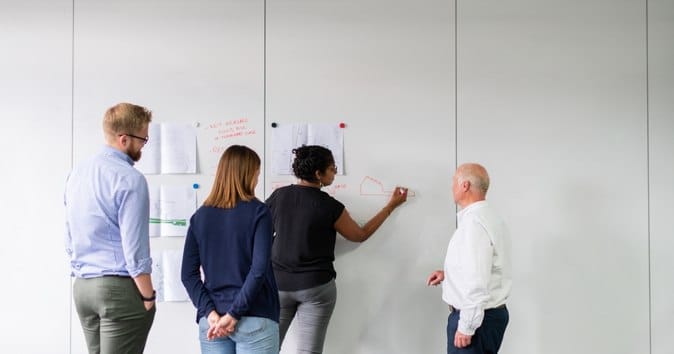How to Create and Implement Performance Management Plans with Examples

Are you struggling to manage team performance? Has your performance management plan remained the same since not been updated since the 90s?
Or, maybe you don't even have a plan because you have a thousand other things to worry about. If any of these are true, don't worry, you're not alone!
Not only do 90%Opens in a new tab of HR managers think their performance review process isn’t truly accurate, but a TruQu study also shows that 94%Opens in a new tab of HR staff believe that yearly performance management cycles need to be updated.
If you agree with either of these sentiments, then this guide is for you. We'll review what a continuous performance management plan looks like in 2024, break down how to create an effective plan of your own, AND how to implement it at your company.
So, without further ado, let's get into it.
What is a performance management plan?
A performance management plan is a systematic process that a company adopts to allow individuals and team members to take an active role in improving their performance and growth, plus how to continue helping the company in achieving company goals.

How do you create performance management plans?
Creating performance management plans is a 4-step process; establishing expectations and goals, regular follow-ups, evaluating performance, and taking action.
Here’s a breakdown of each step:
1. Establish expectations and goals
When putting together an effective performance management plan for an employee, it's necessary to first come up with precise goals for them to achieve.
You need to lay out specific expectations that you want your employees to meet, and those expectations should be heavily influenced by conversations between manager and employee.
Think about this step as providing employees with a destination to reach. It doesn’t make sense to have employees working towards the unknown. A good way to do this is by using KPIs or OKRs to track employee performance.
When setting goals and performance expectations for employees, you should include reachable goals and stretch goals – challenging and ambitious objectives that will really push the employee’s skills.
This is one-way senior management can motivate employees and further their career development without overwhelming them.
While you don’t want the goals to be too readily attainable, so you can make use of maximum employee potential, you also don’t want them to be too far out of reach that workers get discouraged.
Additionally, the goals should benefit the company as well as the worker. For example, if the goal is to boost employee productivity by 15 percent, it should be tied to a consequential 15 percent salary raise.
Once you have strategic goals in place, you need to communicate them clearly to employees. Whether they're individual or team goals, when all sides understand what’s expected of them, they’re more likely to meet those goals.
2. Plan regular follow-ups
One of the key differences between traditional performance managementOpens in a new tab systems and continuous performance management plans is the frequency of conducting reviews.
Gone are the days of the annual review. Setting clear goals and expectations at the beginning of the year isn’t enough to get them well.
You need to track the progress being made throughout the year, and you need to do it regularly.
This will give you insight into the level of progress for that particular employee and what, if any, adjustments need to be made.
Check-ins can also serve as an opportunity to remind employees of the objectives and how they can go about achieving them
These follow-ups can be on a quarterly, monthly, bi-weekly, or weekly basis depending on the size of the company and the goals.
Additionally, there’s no need to drag out the reviews – just keep them simple and straight to the point.
If possible, send a few discussion topics to the employee(s) beforehand so they can come prepared and save time.
For 10 reasons why the annual review is no longer enough, check out this white paper!
3. Evaluate Performance
The next step in developing a good performance management plan is to assess the information you gathered after each check-in.
After all, the whole point of holding review meetings and tracking progress is to evaluate the performance of your employees against the set objectives.
As a result, you should be able to form a good idea of the employee's standing and whether you need to adjust the performance management plan in place.
For example, you might find that the employee did an excellent job and so deserves a boost in pay or benefits.
On the other hand, you might find that the worker didn’t deliver a satisfactory output and so needs additional training or more support from managers.
Either way there is still room to improve. The best part of a continuous performance management plan is that it can be adjusted, so employers can work on mitigating performance in the moment, rather than months later after the chance is already gone, which aligns with the principles of enterprise performance management.
Not only will these strategies help you do a performance appraisal, but they can also provide guidelines for a performance improvement plan, if one becomes necessary.
4. Take action
The final step in your performance management plan is to take action according to your findings in the previous step.
Deciding on the appropriate action isn’t an easy task for any manager, but it’s the only way to achieve growth at the individual, team, and organizational levels.
So, after evaluating the performance of your employees, keep the following in mind:
If the employee fails to meet the set expectations, try to determine the cause of the shortcoming.
Perhaps there were extenuating circumstances that required their attention for a few months or something of the sort.
You should start the correction path by offering the employee more training, or by offering a position in a different department that’s more suitable for their skills.
Or sometimes, an employee just needs some additional support, emotionally or professionally.
Also, take a look at the goals trying to be achieved with an analytical eye and consider the possibility that they’re too much of a stretch.
If multiple employees are having a hard time achieving the goals you’ve laid out, the fault may be on your part due to improper or unrealistic expectations.
In this case, take a step back to modify the goals.
If the employee did better than expected and managed to surpass the set objectives, make sure to show them the recognition they deserve.
This recognition is most impactful when it comes as part of an employee recognition program. In fact, employee recognition can lead to 2x lower turnover and boost productivity. Social Recognition® can help with that.
If the employee only managed to just meet expectations, this is still success that requires recognition and reward. It doesn’t have to be as significant as the previous case, but improvement regardless of how much deserves recognition.
Whatever the result of this planning framework is, it's important to talk with the employee about ways they can improve their performance to get to the next level of their career.

How to implement performance management plans
A continuous performance management plan is only effective if you manage to properly implement it into your company’s culture.
The following steps will help you incorporate the best practices to implement a plan that overcomes the flaws of typical performance managementOpens in a new tabprocesses.
1. Develop an outline
Your first order of business is to create an outline of the employee performance management program. This will give the plan a solid foundation to build a strong cycle of feedback.
The outline should include the organization’s vision, goals, and objectives. It should also explain why these set outcomes are important and how managers and teams are expected to achieve them.
Additionally, consider adding details related to things like company-wide standards for employee evaluation, frequency of performance reviews, and methods of delivering feedback (for example, with Conversations® from Workhuman).
2. Schedule managerial meetings and training sessions
Once your outline is ready, you should start familiarizing the managerial staff with the plan. Call meetings with managers of departments and team leaders to explain the goals and methods of achieving set goals.
Training sessions may be necessary to help managers better execute the plan and guide the employees they manage. If so, be sure to organize the sessions early on.
The sooner the managerial staff is on board, the sooner you’ll be able to start the process and collect feedback.
3. Inform employees and start observing
Next, you need to inform your employees about the new changes. When employees understand why there’s a new performance management system, how it can benefit them, and how they can participate, they’re more likely to contribute to its success.
One of the biggest challenges when implementing performance managementOpens in a new tabplans is that they’re often disconnected.
Briefing employees and aligning their metrics to objectives is an efficient way to resolve the issue and optimize the system.
Once your new performance management cycle begins, it’s time for managers to start observing the performance of employees given the new and improved guidelines.
Managers will use observation methods depending on your structure, but some options include taking notes, self-assessment forms, and gathering feedback from coworkers.

4. Hold the first formal review
After some time spent in observation, there should be a formal review where managers discuss the outcome with the employees in their departments.
Prepare yourself for some resistance at first; after all, a new system is expected to have hiccups during the first review.
That said, such a meeting typically involves job-specific performance reviews, free discussion, management feedback, and identifying development areas.
Before the meeting ends, be sure to set a date for the next one. And consider sending out an anonymous survey after the meeting to get employee feedback without putting them on the spot.
5. Organize training and conduct informal follow-up meetings
After the first formal review, managers should organize training for employees who require improvement in the areas discussed.
These sessions should be conducted during working hours and should not prevent employees from their day-to-day tasks.
Additionally, managers should hold informal meetings to catch up with their employees regarding their performance, concerns they may have, or support they may need.
This helps keep both managers and employees on track.
6. Obtain feedback and make changes
Feedback is crucial when implementing new strategies, so you need to ask managers and employees to submit anonymous feedback on your new performance management plan.
This will give you better insight into how things are going from their point of view.
Carefully review the feedback to know if changes can be made to optimize your performance management process. If an employee or manager submitted suggestions, consider adding them to your list of tweaks.

FAQs
What elements make employee performance management effective?
Effective performance management should include planning and setting expectations, monitoring performance regularly, skill development, periodic performance rating, and rewarding good performance.
What are the top performance management problems?
Common performance management issues include poor prioritizing skills, lost time, slow response times, difficulty in focusing on tasks, and missing deadlines.
Wrapping up
Traditional performance reviews are no longer effective enough to achieve modern-day company growth goals.
Instead, businesses are switching to continuous performance management plans to overcome the shortcomings of typical performance management systems.
Intuitive software can help you implement continuous performance management in your company. Check out our solutions for more information.